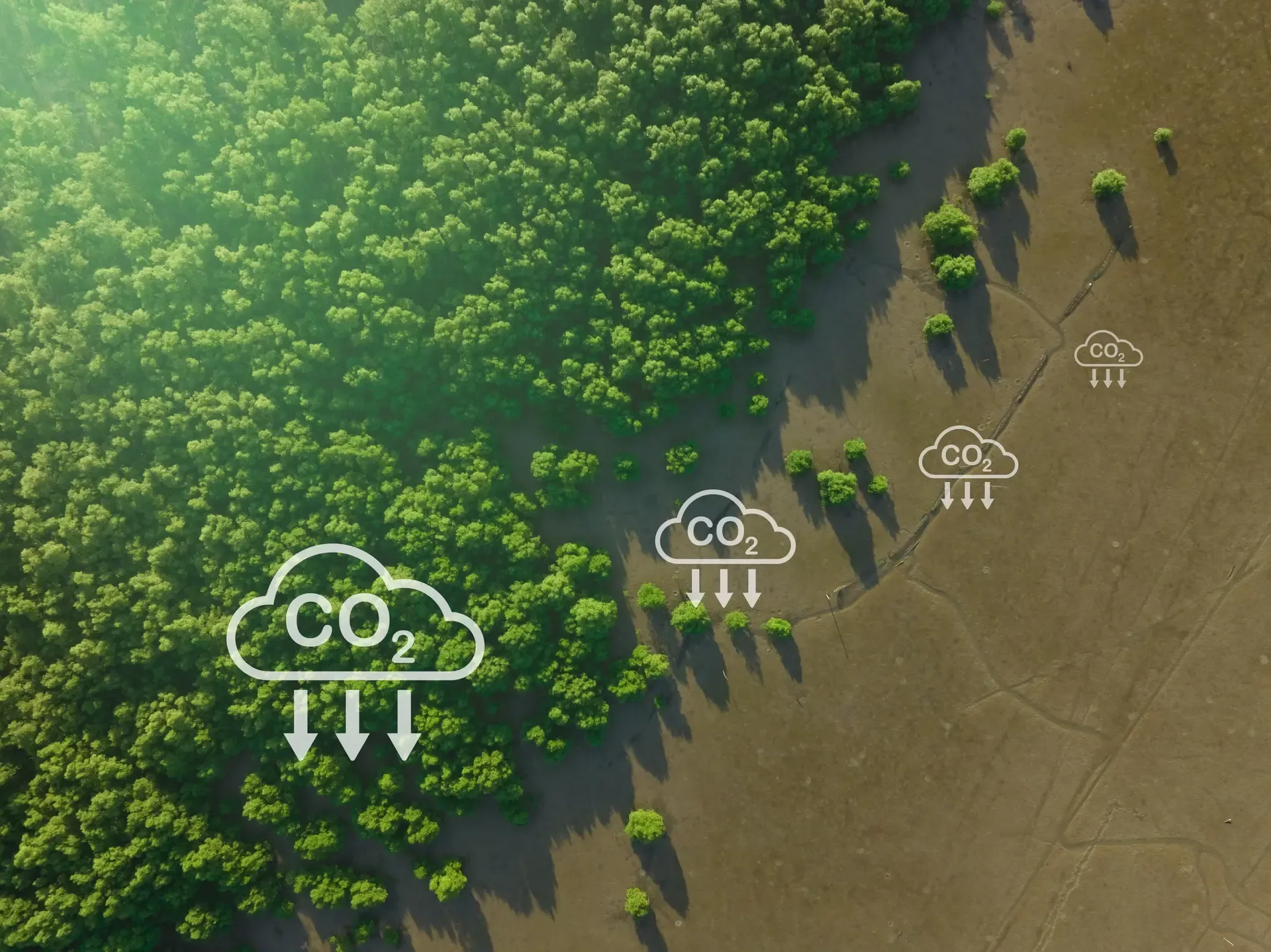FEATURE: Dynamic baselines are the necessary future of forest carbon accounting

THIS STORY WAS ORIGINALLY PUBLISHED IN QC INTEL:
Quantum Commodity Intelligence – Lynn Riley is senior manager of climate science at the American Forest Foundation
As the voluntary carbon market continues to evolve, so does the critical need for clear standards to maximise the impact of natural climate solutions. Much work has already been done in this space by standards bodies and project developers committed to ensuring the integrity climate impact claims of carbon credits. As science has evolved, leaders in the natural climate solutions space have begun applying a precedent-setting approach to ensuring the integrity of forest-based carbon credits: dynamic baselines.
Traditionally, baselines are established manually by the project developer, whose model predicts what would have happened in the absence of their project, then compares that to what actually happens in the project, and attributes the delta between the two scenarios as the climate mitigation created by the project.
Human judgement
Although there is nothing inherently wrong in this approach, it does require human judgement – and the humans making the judgements are usually also the ones who stand to benefit from the issuance and sales of credits. This exposes projects to the risk of over-crediting.
Dynamic baselines are those derived from independent, transparently available, frequently updated datasets in which statistical matching methods identify unenrolled areas of sufficient similarity that they can be considered on a similar path and scale of carbon capture and storage as the project they are matched with.
“Adopters see dynamic baselines as a critical innovation to improve the credibility of nature-based carbon projects and carbon markets in general”
A variety of dynamic baseline adopters are applauding the merits of this innovation. Adopters include third-party ratings agencies using internally developed dynamic baselines as their additionality barometers when assessing forest carbon projects; academics using dynamic baseline-like approaches to document occurrences of over-crediting; and standards themselves, which are directing new methodology development to the dynamic baseline approach.
All these adopters see dynamic baselines as a critical innovation to improve the credibility of nature-based carbon projects and carbon markets in general.
Let us be clear: traditional modeled baselines have helped carbon projects accomplish incredible things over the past two decades, driving hundreds of millions of dollars to jumpstarting natural climate solutions and supporting rural and indigenous communities. Those of us who have developed dynamic baseline approaches are standing on the shoulders of giants and are seeking to make a good thing even better.
So, how do dynamic baselines represent an improvement over the status quo, and who uses them?
The American Forest Foundation (AFF) co-developed the first dynamic baseline methodology for improved forest management – Verra methodology VM0045 – with The Nature Conservancy (TNC) and TerraCarbon, and the methodology was approved in 2022. The first dynamic baseline methodology for afforestation, reforestation, and regeneration – Verra Methodology VM0047 – was developed by TerraCarbon and Silvestrum Climate Associates and approved in 2023.
AFF and TNC implement VM0045 and VM0047 through the Family Forest Carbon Program (FFCP), one of the first carbon projects to deploy dynamic baselines, with the first issuance of credits on track for later this year. FFCP brings together family forest owners and companies to address climate change, improve forest health, and support American communities.
In its more than four years implementing the dynamic baseline approach through FFCP, AFF has learned what sets a dynamic baseline’s integrity apart from other approaches. Below we outline six key learnings from deploying a dynamic baseline to meet the market’s – and the world’s – need for credible climate mitigation. The headline is this: dynamic baselines utilise the best data, science, and statistical methods to take subjective judgment out of the equation and more accurately measure what did happen versus what could have happened as a result of the carbon project, giving us a closer estimation of true climate mitigation impact.
One, dynamic baselines must be derived from standardised, independent, third-party, transparent datasets to prevent bias that leads to over-crediting.
There is a clear conflict of interest between a project developer’s financial gain and their choice in where they source data. Though well-intentioned, bias is present, and studies suggest that not even third-party verification is sufficient to prevent bias from leading to over-crediting.
Using third-party, independent, standardised sources takes subjectivity out of the equation. Ensuring third-party data is transparent enables ratings agencies and others to reproduce results, compare them to alternative datasets, and continue to drive toward even better baseline data.
Two, dynamic baselines must be matched to projects using all variables relevant to the occurrence of the project activity and check for unobservable variables, so risk of adverse selection is minimised.
Dynamic baselines are only as good as their matching and prevention of project developers holding information that allows them to enroll project areas that will outperform their matched baseline regardless of the project’s intervention, a situation called “adverse selection”.
The key is to determine and use the factors that make a good match for properties with similar forest management behavior – for VM0045 for example, influences on harvest operability, such as distance to roads; timber merchantability, like commercial volume and being in the geographic relation to mill capacity; and history of harvesting, like stand age. These are among the variables required for matching within VM0045.
Three, dynamic baselines must standardise and safeguard match quality so we compare like with like and use the best matches. This must be defined by a standardised process for evaluating match quality, such as in VM0045 and VM0047, which set a threshold under which matches are deemed insufficient for applying the methodology.
In the dynamic world of forest management, multiple baseline scenarios may be plausible, but methodologies must select baselines that are not only plausible, but the most plausible to the project. This avoids setting less plausible assumptions like perpetual management for net present value, as some historical carbon projects have done. Evidence shows that such management may be plausible, but is often not the most plausible behaviour, given that management is often not economically rational but based on a diverse set of motivations.
Four, dynamic baselines must be frequently updated on a scale relevant to the project activity and its drivers, so that it picks up on events and trends that matter.
The geographic and temporal nature of baseline datasets should match the geographic and temporal nature of the events the baseline is intended to pick up. Having enough geographic resolution is also critical to ensuring enough similar areas for matching exist. Too few, and a dynamic baseline cannot be used.
Five, dynamic baselines must be observed and utilised to assess additionality ex-post, so that we do not take credit for an unproven hypothesis. Forecasts of the potential credits generated from a project activity relative to its baseline are critical for determining the viability of a carbon project for project developers and credit purchasers. Actually generating credits based on forecasts, however, is akin to forecasting the weather – valuable, but sometimes wrong.
Dynamic baselines with ex-post accounting only count after measurements have occurred, just as is required for project areas. This ensures that not only do project measurements reflect what really happened, but the baseline does too. Other methods without ex-post dynamic baseline true ups include assumptions of what could have happened, rather than what did. Real dynamic baselines do not credit based on those “what-ifs”.
Six, dynamic baselines must not be limited by today’s mental models, but rather create space for external, unpredictable, uncertain, and ambiguous factors to be realised dynamically in real time, so that our understanding today does not limit how well our baselines work in the future. Not only must the data behind baselines be independent and dynamic, but the baseline mechanism itself also must dynamically omit and insert the most relevant drivers of baseline climate outcomes.
“The most important assumptions of a model are not in the equations, but what’s not in them; not in the documentation, but unstated; not in the variables on the computer screen, but in the blank spaces around them,” said systems thinker John Sterman. Who, for example, could have predicted a global pandemic, and its impact on timber markets?
Dynamic baselines avert this limitation and let dynamic natural systems take their course, whatever those drivers may be. This allows us to acknowledge that we don’t yet know the unknowns in increasingly complex ecosystems – and we do not have to. We can still create real, relevant accounting via matched dynamic baselines.
Truly dynamic
A baseline is truly dynamic when it incorporates each of these six pieces; anything less leaves room for inaccurate crediting. For example, periodically updated baseline models may meet learnings two, four, and five, but can still be limited by project developer bias depending on where they source the data and where models do not include unknown socio-economic drivers that will ultimately drive land management.
We encourage credit purchasers to ask about these six elements when performing due diligence of credit suppliers’ approaches.
Dynamic baselines are not without challenges. The most notable of which are: accessibility of data sources that meet the above criteria in all geographies; the continued need to test for and minimise adverse selection; the reduced predictability of baseline estimates and credit production relative to modeled baselines and all of the uncertainty that introduces into a project; and the need for a cultural shift among standards, project developers, and others within the market toward acceptance of these new levels of robustness.
As a result, dynamic baselines are not currently accessible to all project activities and locations.
The more we can promote understanding of these key elements, their purpose, and what makes them trustworthy, the more we can meet the needs of those who have yet to engage in the voluntary carbon market. Some may say these challenges are too hard; we say, look at what we’re already doing – the shift toward dynamic has already begun.
The small landowners who have raised their hand to participate in FFCP’s implementation of the dynamic baseline approach are creating verified climate mitigation toward our remaining global carbon budget.
The more we minimise the risk of over-crediting and learn and iterate upon dynamic baselines and other methodological innovations, the greater impact we can make for people and the planet. We must align accounting with the way people, nature, and their contexts exist: dynamically.
Related Articles

March 11, 2024
FEATURE: QC Intel Highlights Premium Option for Enrolling Landowners
AFF has added a new category that will allow landowners enrolled in FFCP to receive higher payments for their participation, while the program has also expanded into Ohio.

April 10, 2024
Dynamic Baselines and a Plea for Integrity
Stakeholders around the globe have emphasized the critical role the voluntary carbon market can play in keeping the planet from warming beyond 1.5 degrees Celsius.

November 3, 2023
FEATURE: Could Dynamic Baselines Help Alleviate Over-Crediting Concerns?
The voluntary carbon market has been the focus of a number of critical reports recently, questioning the integrity of credits. Dynamic baselines are an answer to the criticism.